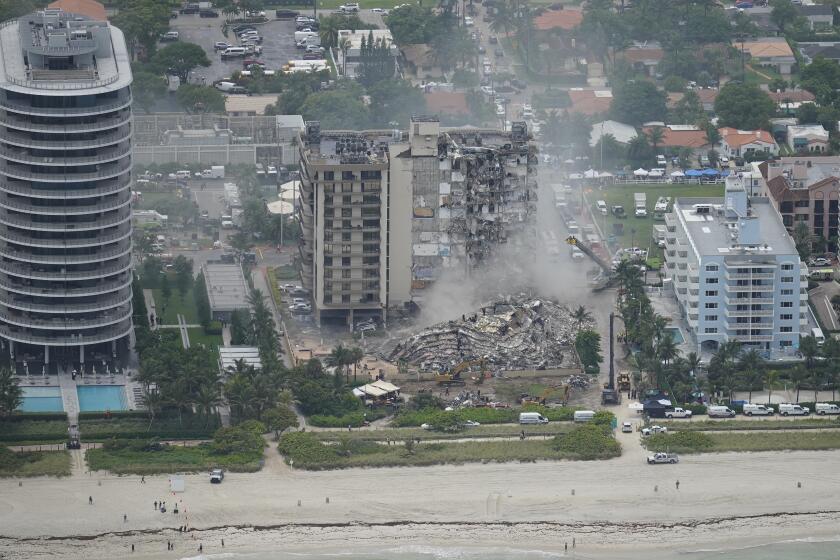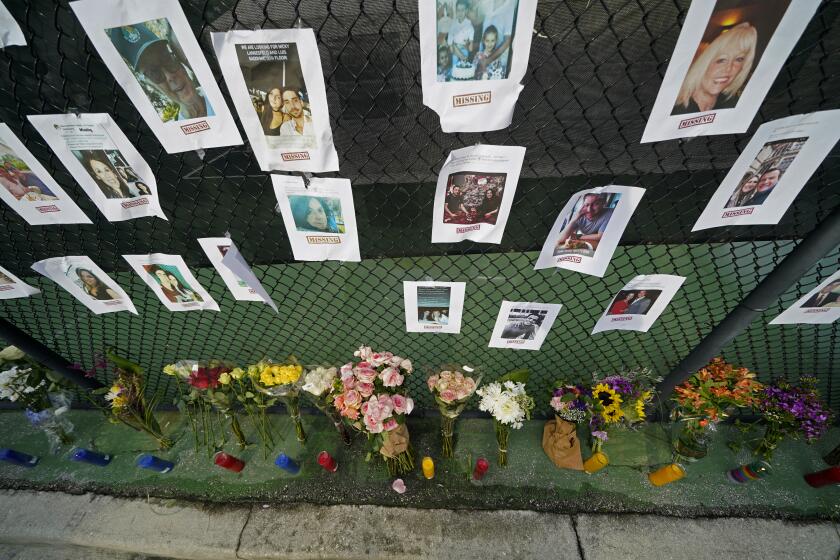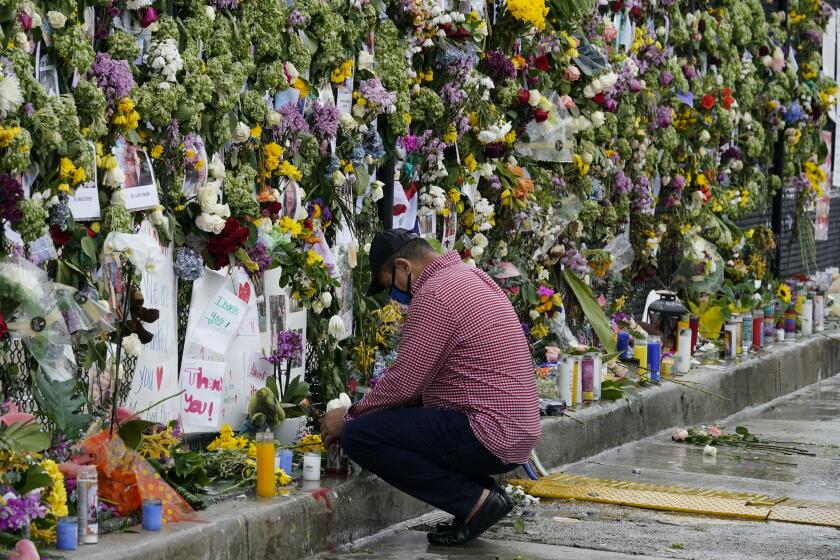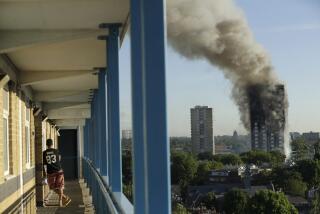‘A limbo that’s a living nightmare’: One family’s wait for the missing of a collapsed Florida condo
- Share via
SURFSIDE, Fla. — When Pablo Rodriguez got the call in the early hours of June 24 that Champlain Towers South had collapsed, he had some hope that his mother and grandmother had survived.
Switching on the TV and looking at images of the pile of rubble, the 40-year-old attorney could see that portions of his mother’s condominium building were still standing. Maybe her apartment hadn’t fallen — maybe somehow she and his grandmother had found a way to escape.
Scrolling frantically on his cellphone for news as his wife, Vivian Lasaga, drove him across Miami, he found a video of the collapse that showed No. 1211, his mother’s penthouse-floor apartment, with its patio lounger and pots of basil and parsley on the balcony, drop out of existence.
Seconds after it crashed to the ground, another stack of apartments to the east tumbled on top of it, collapsing into a flickering, smoking pile.
“It felt like my heart had been ripped out of my chest,” he said. “At that moment, the hope that maybe they made it out went out the window.”
Ten days after the condominium disintegrated into a heap of slab and tangled metal, with rescuers suspending their search for possible survivors in order to prepare for demolition work beginning as early as Sunday for safety reasons on the remaining tower, only 24 bodies have been recovered from the rubble. Rodriguez’s mother, Elena Blasser, 64, and his grandmother, Elena Chavez, 88, are among more than 121 people still classified as missing.
“I’m just sitting here in a limbo that’s a living nightmare,” Rodriguez said. “It doesn’t end. It’s all just been one really long day — one day runs into the next one and you’re like, ‘Well, where did the day go?’”
Rodriguez says he has hardly slept as hundreds of first responders — specialist urban search-and-rescuers from Florida, Israel and Mexico — have swept the pile of concrete and steel with cameras, sonar and canines. They have lifted concrete with buckets and heavy cranes, jackhammered into huge slabs and dug a 20-feet-wide, 40-feet-deep trench in a race to find survivors.
A woman who lived in No. 611, exactly six apartments below his mother, managed to run down the stairs and escape from the building. A 15-year-old boy who lived two floors down was pulled from the rubble alive and with few injuries, but his mother died. No survivors have been rescued since the day the tower collapsed. The stench of bodies from the rubble has gotten stronger.
Some families have complained that rescue workers have taken too long, but Rodriguez doesn’t blame anyone working on the pile for the agonizingly slow pace of the search. He understands they’re working 12-hour shifts in sweltering heat on slippery terrain packed with jagged steel rebar.
Over the last week, search-and-rescue teams have lugged more than 3 million pounds of concrete from the rubble. But fires raging through the debris, tropical rainstorms and the structural instability of the partially remaining tower have frequently forced them to pause.
On Thursday, crews halted the search for 14 hours after structural engineers detected six to 12 inches of movement in a large column hanging from the structure that could fall and damage the support columns in the basement garage. By Thursday evening, the structure was deemed stable enough for some search-and-rescue teams to go back to work in a small area of the pile. But local officials are now planning to demolish the remaining tower immediately as Tropical Storm Elsa barrels toward South Florida.
Many residents and second-home owners in the tiny coastal city of Surfside, just a few miles northeast of Miami, spoke of being unnerved about their future on this barrier island.
Surfside Mayor Charles W. Burkett, who has visited the site several times each day, said the pile of rubble was getting smaller as men and women haul debris from the site, mostly by hand and with buckets.
Every day, he said, the families of the missing ask: “Are you digging in this place? Are you finding anything? Are you going fast enough? Can we go faster? Can we keep working — even in the lightning?”
Burkett keeps telling families that he believes search teams will pull somebody out of the rubble alive. But even though his mother and grandmother’s bodies have not been found, Rodriguez has slipped into thinking of them in the past tense.
“She was full of life, she loved to travel, she loved the beach,” he said of his mother. “Family was her No. 1 thing.”
If a miracle happens, Rodriguez said, he would be the happiest person in the world.
But he’s not expecting a miracle. His only hope is that they find “something,” so his family can give his mother and grandmother a proper burial.
::
When Rodriguez arrived in Surfside just hours after the collapse, the mellow beach city just a few miles northeast of Miami had turned into a dystopia of blocked roads, buzzing helicopters and flashing police cruisers.
Joining the rush of people pouring into the family reunification center, he struggled to process what was happening.
The people inside Champlain Towers South reflected the Miami area’s mix of South American immigrants and tourists, Orthodox Jews and sun-chasing retirees.
His grandmother had planned to take his 6-year-old son, John, out for lunch that day and buy him a new bicycle. The whole family was supposed to gather at his home Saturday to hang by the pool.
What would he tell John?
John had seen pictures of the collapse that morning on the news and understood that Ama and Yeyi were in the building.
“Are they OK?” he kept asking. “Can we FaceTime them?”
Pablo and his mother spoke on the phone every day, and John’s grandmother and great-grandmother doted on him. Every Saturday they came to his house, and they would also pick him up for trips to the beach apartment, Disney World and Legoland.
The Saturday after the tower went down was especially hard. Close friends brought their kids over to play with John, and they went out for a Happy Meal.
But John kept asking: “Where are they? “Why aren’t they coming? Can we FaceTime?”
As the scale of the tragedy slowly began to sink in, Rodriguez caught his son tearing up.
“What’s wrong?” he asked.
A memorial in Surfside, Fla., has become a place to pay tribute to those who lived in the condominium that, without warning, fell in the middle of the night.
“Nothing,” John said brightly, wiping his eyes and smiling. “I’m happy!”
On Thursday, Rodriguez and his wife took John to see a grief counselor instead of joining other families to meet President Biden. They were worried about how he was coping. It was more important, Rodriguez thought, that John talk to someone who could help him express what he was feeling.
That evening, when the family sat at home to watch “Captain America: The First Avenger,” John kept staring off into the distance.
“What’s wrong?” Rodriguez asked.
“Ama, Yeyi, Champlain Tower,” John said. “Poof!”
John burst into tears, and Rodriguez had to bolt out of the room to contain his sobs while his wife comforted their son.
“I don’t know if he fully grasps it,” he said. “And I’m not sure I do, either. I’m 40 and I’m having difficulty understanding.”
Earlier that week, when families were invited to the site to witness the rescue effort and try to connect with their loved ones, Rodriguez could not make it all the way there. As he approached the building from two blocks away, he collapsed when he saw the pile behind the remaining building.
“It looks like a movie set for some kind of disaster film,” he said. “Three or four stories tall of nothing but debris.”
::
Elena Chavez and Elena Blasser were born in Cuba, but the family fled to New York during the revolution when Blasser was a girl. After a few years in New York, they lived in Puerto Rico until they moved to Miami in the late ’70s.
Chavez, who was a public school teacher in Puerto Rico, loved to travel so much she still worked as a travel agent at the age of 88. Blasser served as a public school teacher at several Miami-Dade middle and elementary schools before becoming a counselor and vice principal.
More than a decade ago, she moved into the Champlain.
The two-bedroom apartment was a treasured spot for the family — a place where they gathered on the weekends to enjoy the views of the ocean, spend time by the pool, and eat Blasser’s home-cooked eggplant Parmesan and kibbeh.
But she and other owners frequently complained about the lack of maintenance, including cracks around the pool deck, water in the parking garage and paint chipping off the building, Rodriguez said.
On their last phone call, the day before the tower collapsed, she told him she didn’t sleep well because she was woken up at 3 or 4 a.m. as the building made loud creaking noises.
Rodriguez didn’t take it too seriously at the time, but now it gnaws at him — along with all the complaints owners had about the way the condo was managed.
“How could this happen?” he said. “It’s negligence. The biggest question I have is how it was allowed to get that bad? This is a building that collects monthly maintenance fees. How did the city come in and say the building was OK after seeing the report?”
Although the cause of the collapse has yet to be determined, an engineer flagged in a 2018 report that the building had a “major error” where lack of drainage on the pool deck had caused “major structural damage” to a concrete slab below that deck. In November 2018, after receiving a copy of that report, Surfside’s chief building inspector reassured residents that the building was in “good shape.”
According to engineering and architectural experts, multiple factors could have played a role in the tragedy, possibly a compromised foundation or flaws in the building’s design or construction.
The building, which had not completed its required 40-year recertification, was having work done on its roof and about to undergo extensive repairs for rusted steel and damaged concrete.
On Thursday, the body of Magaly Delgado, an 80-year-old Cuban woman who lived three stories beneath his mother, was found. Later that night, a Miami firefighter carried his own daughter, 7, out of the rubble.
Rodriguez is bracing himself for a phone call. Still, he does not think he will be ready when it comes.
Every time Rodriguez lies down and closes his eyes, the video replays itself in his head, and he sees the tower crash down.
He is trying to think of happier times, but even that can be bittersweet.
Opening up Facebook, notifications pop up of family summer beach vacations: photo after photo of his mother, grandmother and son beaming in front of clear Caribbean water on the Turks and Caicos and the Cayman Islands.
“Those were always our happiest moments,” he said. “It’s tough knowing I’m not going to make any new moments with them.”
More to Read
Sign up for Essential California
The most important California stories and recommendations in your inbox every morning.
You may occasionally receive promotional content from the Los Angeles Times.














